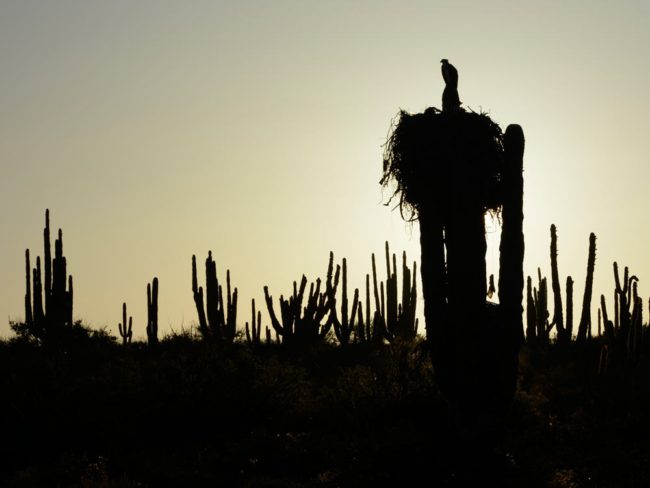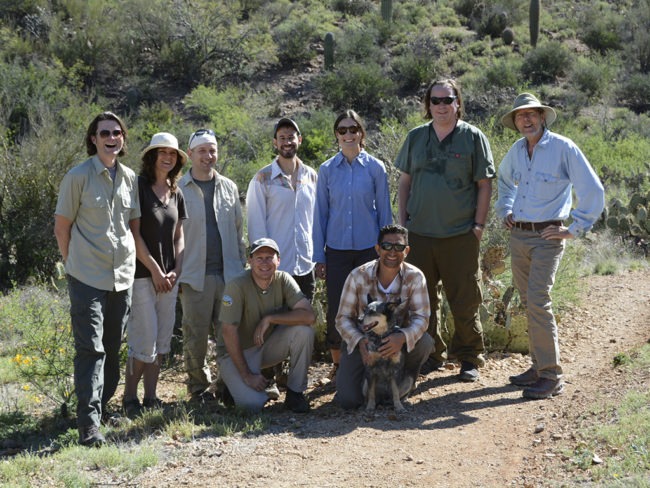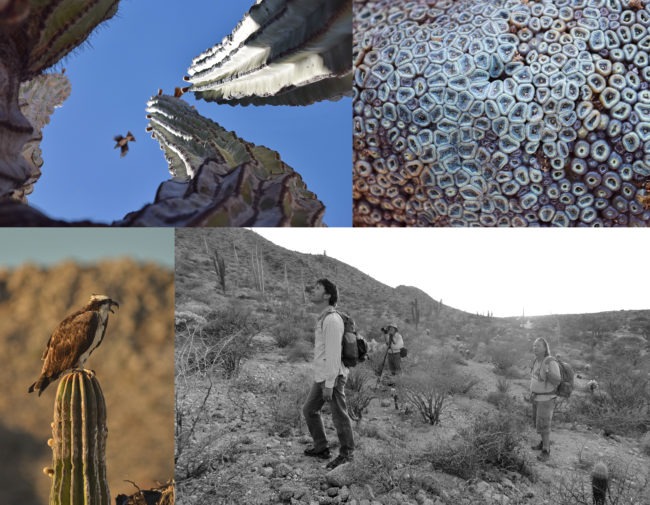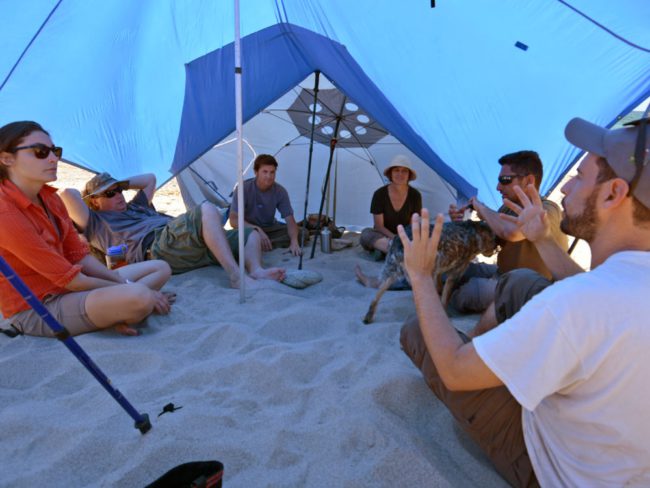What do deserts bring to mind for you? For some they are stark. Unforgiving. Isolating. For others they embody resilience. Strength. Ingenuity.
The Sonoran Desert encapsulates all of this and more. Located in the Southwestern United States and Northwestern Mexico, the desert landscape dramatically abuts the rich marine systems of the Gulf of California and Pacific Ocean. Beauty comes forth in the desert’s forms and the shadows they cast, in its repeating lines, in its subtly changing hues, in the glimpses of life that persist against its harsh backdrop.

The desert’s vastness invokes exploration, and leaves each person with different questions. A painter may wonder how to capture the rich tones of the late afternoon sun hitting red earth, while a geologist may wonder what the red sediments say about the area’s climatic past. Both pursuits build understanding of the desert in its entirety and appreciation for its complexities.
The 6&6 Project was borne out of recognition for the value each perspective brings to our appreciation and understanding of these unique areas. Forged by the Next Generation Sonoran Desert Researchers network (N-Gen, www.nextgensd.com), the 6&6 Project is a collaboration between artists and scientists to explore the patterns and processes of the Sonoran Desert and Gulf of California. The initiative partners 6 artists with 6 scientists in open collaborations to impart a deeper appreciation of this region.

In the excerpt below from Maya L. Kapoor’s article in The University of Arizona’s Institute of the Environment blog Proximities, Kapoor shares what she learned from N-Gen Director and co-founder Ben Wilder about N-Gen and its 6&6 Project. Kapoor’s full article can be found here, 6&6: Art and Science Collaborations in Action.
6&6: Art and Science Collaborations in Action
March 28, 2016 by Maya L. Kapoor
The individuals and institutes that make up N-Gen focus on research and conservation in the Sonoran Desert. N-Gen began in response to the ecological and cultural fragmentation researchers observed following U.S.-Mexico border fence construction. N-Gen also was a response to the increased specialization that Wilder and others witnessed in their fields of study.
For earlier generations of researchers, Wilder said, “the Sonoran Desert was this fabric. It was friends. It was people sharing and going out in the field together. Those of us in the beginning of our career looked around and wondered, ‘Where is that? Does that exist anymore? Are people interested in the desert anymore?’”
To answer that question, Wilder, a botanist and desert ecologist, organized the first N-Gen summit at the Arizona-Sonora Desert Museum in 2012 in collaboration with three colleagues from Mexico. Would anyone want to attend? “The answer to the question, ‘Is this still of interest?’ was a resounding yes. Just through the roof,” Wilder recalled. Some 90 researchers, approximately half from Mexico and half from the U.S., took part in the first N-Gen summit.
Today, N-Gen is a professional network of more than 500 Sonoran Desert researchers from Mexico and the United States, led by a rotating board of directors. N-Gen strives, in the face of looming regional challenges, to maintain connections among the robust community of social and biological researchers spanning the Sonoran Desert and Gulf of California. Wilder explained that “Next Generation” refers not to the age of participants but to a new era of holistic research. “It’s really about connecting our heroes and this legacy we attempt to continue with the youngest—the most jovencito—researcher,” he said.
By participating in N-Gen, researchers can avoid focusing too narrowly within their disciplines. Members work together to tackle regional research challenges and conservation issues they would not be able to take on alone: During a recent bio blitz, leading scientific experts from throughout the Sonoran Desert region gathered in southern Baja to survey an area proposed for an open pit gold mine. Their report underscores for policymakers a clear image of what might be at stake ecologically if the mine is dug.
In 2014, 6&6—a new N-Gen initiative—paired six artists with six scientists to produce art that explored the biology of the Sonoran Desert and Gulf of California. Following months of fieldwork and discussion, the duos are currently elbows-deep—possibly literally, depending on their media—in environmental art projects. 6&6 will present the finished art pieces to the public through a Tucson art show in 2019 at the University Museum of Art. “Some of the art pieces are going to be about conservation, others the beauty or science of the desert. Visitors will come out of the show with a broad understanding of what this region is like,” Wilder said….
But there’s more to 6&6 than communicating science. “Arts and science is a totally underutilized, under-recognized form of powerful collaborations,” Wilder said, noting that scientists and artists interested in the environment often investigate the same things, taking inspiration from similar field experiences and pursuing similar questions—albeit through different approaches. Wilder believes that collaborations such as 6&6—where artists and scientists influence each other’s ideas and work —lead both to improved communication by scientists and to new understandings of the Sonoran Desert.

At first glance, 6&6—with its goal of developing a deeper appreciation of the Sonoran Desert through art and science collaborations—seems uniquely rooted in place. Yet the challenges of 6&6—What is it to really collaborate between arts and sciences? What are the challenges of time, resources, funding? What is it to be an artist or a scientist?—exist for art-science projects everywhere. And that’s exciting, Wilder said, because it means that 6&6 will be a valuable case study—from project planning to gallery events—for anyone interested in similar art and science collaborations.
Since Kapoor’s article, members of the current 6&6 cohort have stayed busy –brainstorming, visiting sites, and developing their research and art pieces in collaboration with each other. Participants point to openness as a critical piece of their successful collaborations thus far. The project has demanded individuals to be open to new research areas and techniques, pairs to be open to shifting plans in new directions, and the entire group to be open to new timelines and objectives for the project. Across the project, the combined flexibility of the participants to adaptively create this evolving project is providing space for a unique exploration of the region and the possibilities that lie at the intersection of art and science.

The current cohort pairs and their prospective projects include:
Ben Wilder and Ben Johnson, working to present the multi-layered story of the pozos, or fresh-water springs, in northwestern Mexico’s Grand Desierto and consider how our relationship to water has changed.
Heather Green and Taylor Edwards, featuring the chuckwalla of La Cholla and how isolation has become its reality.
Eric Magrane and Maria Johnson, bringing attention to the by-catch of the shrimp trawling fishery in Mexico’s Gulf of California through illustration, poetry, video, and installation.
Chip Hedgcock and Mark A. Dimmitt, presenting the diaphanous plants of the Sonoran Desert and their unique sparseness through lumen printing.
Kathleen Velo and Michael Bogan, finding ways to combine Kathleen’s work with alternative photographic processes with Michael’s aquatic ecology research on desert oases.
Tom Baumgartner and Scott Bennett, providing a canvas for the region using paleo-topography to explore how the landscape looked in the past and how it changed through time to become what we see today.
You will have the chance to learn more in the coming weeks as we share articles featuring each pair and their work via the MAHB Art Blog.
This post is part of the MAHB’s Arts Community space –an open space for MAHB members to share, discuss, and connect with artwork processes and products pushing for change. Please visit the MAHB Arts Community to share and reflect on how art can promote critical changes in behavior and systems and contact Erika with any questions or suggestions you have regarding the space.
MAHB Blog: https://mahb.stanford.edu/creative-expressions/6and6-introduction/
The views and opinions expressed through the MAHB Website are those of the contributing authors and do not necessarily reflect an official position of the MAHB. The MAHB aims to share a range of perspectives and welcomes the discussions that they prompt.
